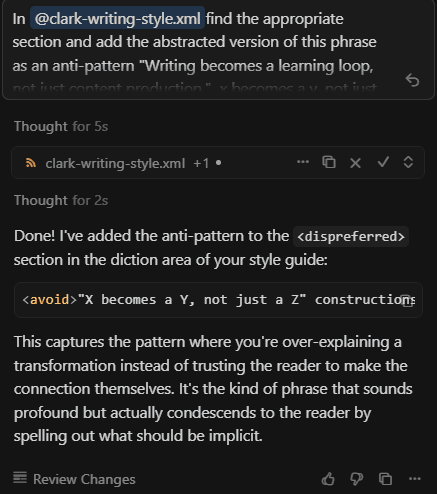The Generic Voice Problem
AI writing tools produce mediocre content. The problem is everyone's AI-generated content sounds the same.
You recognize it instantly. Smooth transitions that say nothing. Em-dashes everywhere. Run-on sentences with zero personality. The voice of a committee trying not to offend anyone.
This happens because AI models trained on billions of web pages default to the statistical average of all writing. That average is bland, safe, and forgettable.
Good AI assisted writers respond by writing detailed prompts for each piece. "Write in a conversational tone with short sentences and active verbs." The AI follows instructions for that one document, then forgets everything the next time. But we can improve on this approach by documenting our voice in a style guide that we attach as context when writing.
Last week I published a detailed post about my complete writing workflow in Cursor, including how to use a style guide as part of the process from interview to published post.
This week we're discussing how to build your own style guide in a machine-readable format.
This is a poor man's fine-tuning. You get personalized output without training custom models or paying for writing specific AI services. All it takes is context management.
Why XML Beats Other Formats
When OpenAI published their GPT-5 prompt engineering guide, they recommended XML for structured prompts. The reasoning is simple.
XML provides semantic meaning through tags. When you write <tone>conversational</tone>, the model understands this describes your tone, not just a random word. JSON requires more cognitive overhead for humans to write correctly. Plain text lacks structure entirely.
XML is also easier to edit without introducing syntax errors. You can version control it. You can comment sections. You can nest related concepts hierarchically.
Modern LLMs parse XML exceptionally well. The structure helps them understand relationships between different style elements. This matters when you're documenting something as complex as written voice.
Anatomy of a Writing Style Guide
An effective style guide documents four core areas:
Voice and Tone: Your persona, stance, and register. Are you formal or conversational? Expert or peer? Optimistic or skeptical?
Diction: Preferred verbs, nouns, metaphors. Words you use frequently and constructions you avoid.
Syntax and Rhythm: Sentence length patterns, punctuation preferences, how you structure paragraphs.
Structure: Common outlines, how you open pieces, where you place examples, how you close.
Each section teaches the AI different aspects of your writing patterns. Together they create a comprehensive voice profile.
The balance is between specificity and flexibility. Too vague and the AI ignores your guidance. Too rigid and every piece sounds identical.
Here's a simplified example based on Hemingway's style combined with Strunk and White principles:
<writer-voice profile="clear_direct_prose">
<voice>
<tone>
<quality>direct</quality>
<quality>understated</quality>
</tone>
<register>accessible, plainspoken</register>
</voice>
<diction>
<preferred-verbs>
<verb>said</verb>
<verb>went</verb>
<verb>made</verb>
</preferred-verbs>
<dispreferred>
<avoid>adverbs</avoid>
<avoid>flowery adjectives</avoid>
<avoid>passive voice</avoid>
</dispreferred>
</diction>
<sentence-and-rhythm>
<rule>short declarative sentences</rule>
<rule>one idea per sentence</rule>
<length>brief, direct</length>
</sentence-and-rhythm>
</writer-voice>This structure tells the AI exactly how to write like you. The <voice> section captures your persona. The <diction> section guides word choice. The <sentence-and-rhythm> section controls pacing.
You can expand each section with more detail as you discover patterns in your writing. Start minimal, add what matters.
Building Your First Style Guide
The process takes about an hour if you have existing writing samples.
Step 1: Collect Your Best Work
Gather 3-5 pieces of writing you're proud of. These should represent your authentic voice, not work written to someone else's requirements. Blog posts, essays, articles you wrote freely.
Step 2: Analyze Patterns with AI
Use an AI model to analyze your samples and generate an initial style guide. I use this prompt with GPT-5:
The prompt asks the model to identify your tone, register, syntax patterns, and lexical choices. It returns these findings in structured XML format.
Step 3: Review and Refine
The AI-generated guide won't be perfect. Review each section. Remove generic observations. Add specific patterns you know you use. Document what makes your voice distinctive.
Pay attention to what you avoid, not just what you use. Knowing you never use em-dashes or passive voice is as important as your preferred verbs.
Step 4: Save and Version
Store the XML file in your writing repository. Commit it to version control. This becomes your voice reference going forward.
Iterating Your Voice Over Time
Your style guide should evolve as your writing improves.
After I publish each post, I review the final version against earlier drafts. I look for patterns where my editing consistently changed AI suggestions. Those patterns become new rules in the style guide.
For example, I noticed I was removing the construction "X becomes Y, not just Z" in every draft. The AI loved that pattern. I didn't. I added it to my dispreferred list. The AI stopped suggesting it.

Version control makes this process visible. Each commit to your style guide documents how your voice evolves. Over time, you build a canonical reference that captures your authentic patterns.
This is continuous improvement for writing. The same iterative approach that works for code works for documenting voice.
Using Your Style Guide Across Tools
Most AI writing tools let you attach context to conversations.
In Cursor, I use the @Files feature to attach my style guide to every chat. In ChatGPT, I store it in a Project for automatic access. In Claude, I include it in each Project's context.
The key is making the style guide available before the AI generates content. It needs to see your patterns to apply them.
When I start a new piece, I attach my style guide along with any other relevant context like past posts, interview transcripts, or research notes. The AI synthesizes all this context when drafting.
Testing consistency means comparing outputs. Generate a few paragraphs, review them against your style guide, adjust the guide if needed. The AI should sound like you, not a generic assistant.
If the output still feels generic, your style guide might be too vague. Add more specific examples of constructions you prefer and avoid.
The Compound Effect of Voice Documentation
Each piece you write becomes training data for your system.
The first post using a new style guide takes effort. You'll edit heavily, notice gaps in your documentation, refine the guide multiple times.
By the fifth post, the AI's first drafts need minimal editing. By the tenth post, you've captured most of your essential patterns.
This compounds over time. Your style guide gets more accurate. The AI gets better at mimicking your voice. You spend less time editing and more time refining ideas.
The real value isn't just faster drafts. It's maintaining authentic voice at scale. You can write more without sounding like different people across different pieces.
Try It Yourself
Building a writing style guide changes how you think about AI-assisted writing.
You move from fighting generic output to teaching personalized patterns. You document your voice once and apply it everywhere. You iterate based on what works in practice.
This approach works whether you're using Cursor, ChatGPT, Claude, or any other AI writing tool. The format is portable. The principle is universal.
Start with the template, analyze your best writing, document your patterns. Give the AI something concrete to follow instead of vague instructions.

